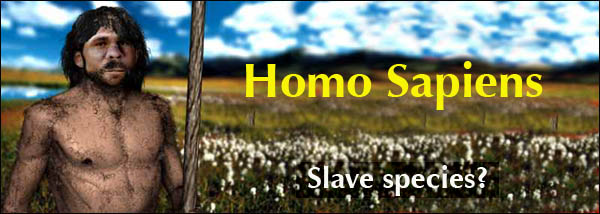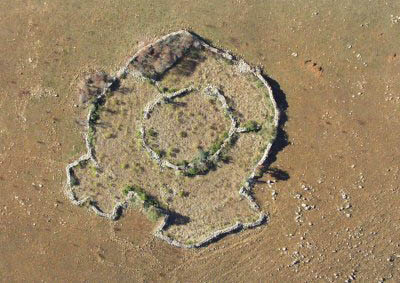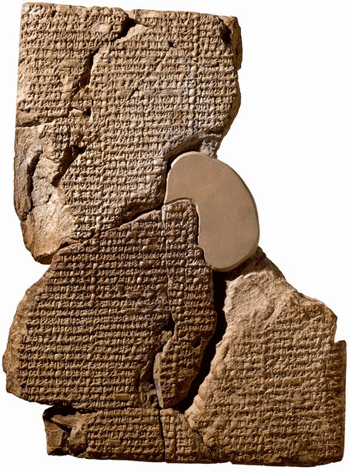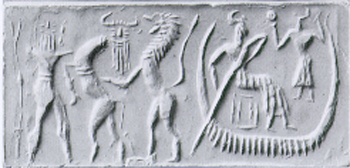

Who made the metropolis? Why?
This story, the Atrahasis, comes from an early Babylonian version of about 1700 BC, but it certainly dates back to Sumerian times. It combines familiar Sumerian motifs of the creation of mankind and the subsequent flood -- just like Genesis. 

 The story starts out with the "gods" -- beings from a planet called Nibiru -- digging ditches and mining for gold as part of an expeditionary team. Modern humans (homo sapiens) did not exist yet; only primitive hominids lived on Earth. There were two groups of "gods", the worker class and the ruling class (i.e. officers). The worker gods had built the infrastructure as well as toiled in the gold mines and, after thousands of years, the work was apparently too much for them.
The story starts out with the "gods" -- beings from a planet called Nibiru -- digging ditches and mining for gold as part of an expeditionary team. Modern humans (homo sapiens) did not exist yet; only primitive hominids lived on Earth. There were two groups of "gods", the worker class and the ruling class (i.e. officers). The worker gods had built the infrastructure as well as toiled in the gold mines and, after thousands of years, the work was apparently too much for them.
The gods had to dig out the canals
Had to clear channels,
the lifelines of the land,
The gods dug out the Tigris river bed
And then they dug out the Euphrates. --(Dalley 9, Atrahasis)
After 3,600 years of this work, the gods finally begin to complain. They decide to go on strike, burning their tools and surrounding the chief god Enlil's "dwelling" (his temple). Enlil's vizier, Nusku, gets Enlil out of bed and alerts him to the angry mob outside. Enlil is scared. (His face is described as being "sallow as a tamarisk.") The vizier Nusku advises Enlil to summon the other great gods, especially Anu (sky-god) and Enki (the clever god of the fresh waters). Anu advises Enlil to ascertain who is the ringleader of the rebellion. They send Nusku out to ask the mob of gods who is their leader. The mob answers, "Every single one of us gods has declared war!" (Dalley 12, Atrahasis).
Since the upper-class gods now see that the work of the lower-class gods "was too hard," they decide to sacrifice one of the rebels for the good of all. They will take one god, kill him, and make mankind by mixing the god's flesh and blood with clay:
Belit-ili the womb-goddess is present,After Enki instructs them on purification rituals for the first, seventh and fifteenth of every month, the gods slaughter Geshtu-e, "a god who had intelligence" (his name means "ear" or "wisdom") and form mankind from his blood and some clay. After the birth goddess mixes the clay, all the gods troop by and spit on it. Then Enki and the womb-goddess take the clay into "the room of fate," where The womb-goddesses were assembled.
Let the womb-goddess create offspring,
And let man bear the load of the gods! (Dalley 14-15, Atrahasis)
He [Enki] trod the clay in her presence;The creation of man seems to be described as a type of cloning and what we would today consider in vitro fertilization.
She kept reciting an incantation,
For Enki, staying in her presence, made her recite it.
When she had finished her incantation,
She pinched off fourteen pieces of clay,
And set seven pieces on the right,
Seven on the left.
Between them she put down a mud brick. (Dalley 16, Atrahasis)
The result was a hybrid or "evolved human" with enhanced intellect who could perform the physical duties of the worker gods and also take care of the needs of all the gods.
We are told, in other texts, that the expedition came for gold and that great quantities were mined and shipped off the planet. The community in South Africa was called "Abzu" and was the prime location of the mining operation.
Since these events appear to coincide with the dates of "Mitochondrial Eve" (i.e. 150,000 to 250,000 BP) and appear to be located in the richest gold mining region on the planet (Abzu), some researchers are thinking that the Sumerian legends may, in fact, be based on historical events.
 According to the same texts, once the mining expedition ended it was decided that the human population should be allowed to perish in a flood which was predicted by the atronomer of the "gods." Apparently, the cyclical passage of the home planet of the gods, Nibiru, was going to bring it close enough to the orbit of Earth that its gravity would cause the oceans to rise and flood the land, putting an end to the hybrid species -- homo sapiens.
According to the same texts, once the mining expedition ended it was decided that the human population should be allowed to perish in a flood which was predicted by the atronomer of the "gods." Apparently, the cyclical passage of the home planet of the gods, Nibiru, was going to bring it close enough to the orbit of Earth that its gravity would cause the oceans to rise and flood the land, putting an end to the hybrid species -- homo sapiens.
According to the story, one of the "gods" had sympathy for a particular human, Zuisudra, and warned him to construct a boat to ride out the flood. This eventually became the basis for the story of Noah in the book of Genesis.
Did this really happen? The only other explanation is to imagine that the Sumerian legends, acknowledging life on other planets and human cloning, were extraordinary science-fiction. This in itself would be amazing. But we now have evidence that the mining city, Abzu, is real and that it existed in the same era as the sudden evolution of hominids to homo sapiens.
Just think about this for a while.


